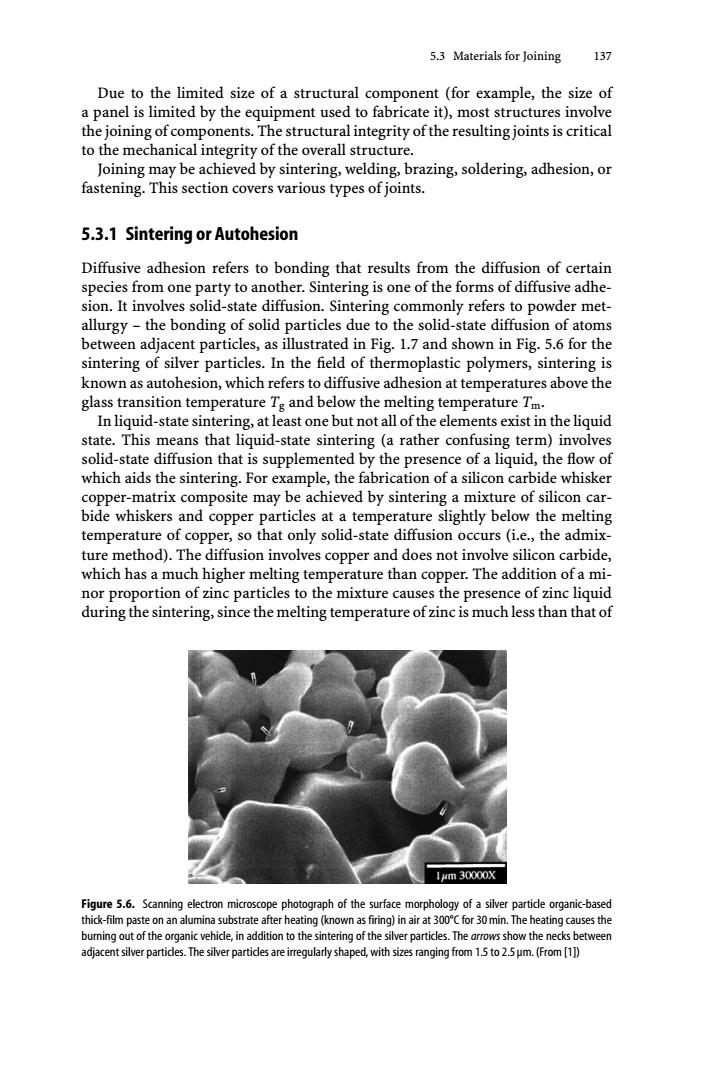正在加载图片...

5.3 Materials for Joining 137 Due to the limited size of a structural component (for example,the size of a panel is limited by the equipment used to fabricate it),most structures involve the joining of components.The structural integrity of the resulting joints is critical to the mechanical integrity of the overall structure. Joining may be achieved by sintering,welding,brazing,soldering,adhesion,or fastening.This section covers various types of joints. 5.3.1 Sintering or Autohesion Diffusive adhesion refers to bonding that results from the diffusion of certain species from one party to another.Sintering is one of the forms of diffusive adhe- sion.It involves solid-state diffusion.Sintering commonly refers to powder met- allurgy-the bonding of solid particles due to the solid-state diffusion of atoms between adjacent particles,as illustrated in Fig.1.7 and shown in Fig.5.6 for the sintering of silver particles.In the field of thermoplastic polymers,sintering is known as autohesion,which refers to diffusive adhesion at temperatures above the glass transition temperature Tg and below the melting temperature Tm. In liquid-state sintering,at least one but not all of the elements exist in the liquid state.This means that liquid-state sintering (a rather confusing term)involves solid-state diffusion that is supplemented by the presence of a liquid,the flow of which aids the sintering.For example,the fabrication of a silicon carbide whisker copper-matrix composite may be achieved by sintering a mixture of silicon car- bide whiskers and copper particles at a temperature slightly below the melting temperature of copper,so that only solid-state diffusion occurs(i.e.,the admix- ture method).The diffusion involves copper and does not involve silicon carbide, which has a much higher melting temperature than copper.The addition of a mi- nor proportion of zinc particles to the mixture causes the presence of zinc liquid during the sintering,since the melting temperature of zinc is much less than that of 1Hm30000X Figure 5.6.Scanning electron microscope photograph of the surface morphology of a silver particle organic-based thick-film paste on an alumina substrate after heating(known as firing)in air at 300C for 30 min.The heating causes the buring out of the organic vehide,in addition to the sintering of the silver particles.The arrows show the necks between adjacent silver partices.The silver particles are irregularly shaped,with sizes ranging from 1.5 to 2.5 um.(From [1])5.3 Materials for Joining 137 Due to the limited size of a structural component (for example, the size of a panel is limited by the equipment used to fabricate it), most structures involve the joining of components. The structural integrity of the resulting joints is critical to the mechanical integrity of the overall structure. Joining may be achieved by sintering, welding, brazing, soldering, adhesion, or fastening. This section covers various types of joints. 5.3.1 Sintering or Autohesion Diffusive adhesion refers to bonding that results from the diffusion of certain species from one party to another. Sintering is one of the forms of diffusive adhesion. It involves solid-state diffusion. Sintering commonly refers to powder metallurgy – the bonding of solid particles due to the solid-state diffusion of atoms between adjacent particles, as illustrated in Fig. 1.7 and shown in Fig. 5.6 for the sintering of silver particles. In the field of thermoplastic polymers, sintering is known as autohesion, which refers to diffusive adhesion at temperatures above the glass transition temperature Tg and below the melting temperature Tm. In liquid-state sintering, at least one but not all of the elements exist in the liquid state. This means that liquid-state sintering (a rather confusing term) involves solid-state diffusion that is supplemented by the presence of a liquid, the flow of which aids the sintering. For example, the fabrication of a silicon carbide whisker copper-matrix composite may be achieved by sintering a mixture of silicon carbide whiskers and copper particles at a temperature slightly below the melting temperature of copper, so that only solid-state diffusion occurs (i.e., the admixture method). The diffusion involves copper and does not involve silicon carbide, which has a much higher melting temperature than copper. The addition of a minor proportion of zinc particles to the mixture causes the presence of zinc liquid during the sintering, since the melting temperature of zinc is much less than that of Figure 5.6. Scanning electron microscope photograph of the surface morphology of a silver particle organic-based thick-film paste on an alumina substrate after heating (known as firing) in air at 300°C for 30min. The heating causes the burning out of the organic vehicle, in addition to the sintering of the silver particles. The arrows show the necks between adjacent silver particles. The silver particles are irregularly shaped, with sizes ranging from 1.5 to 2.5μm. (From [1])